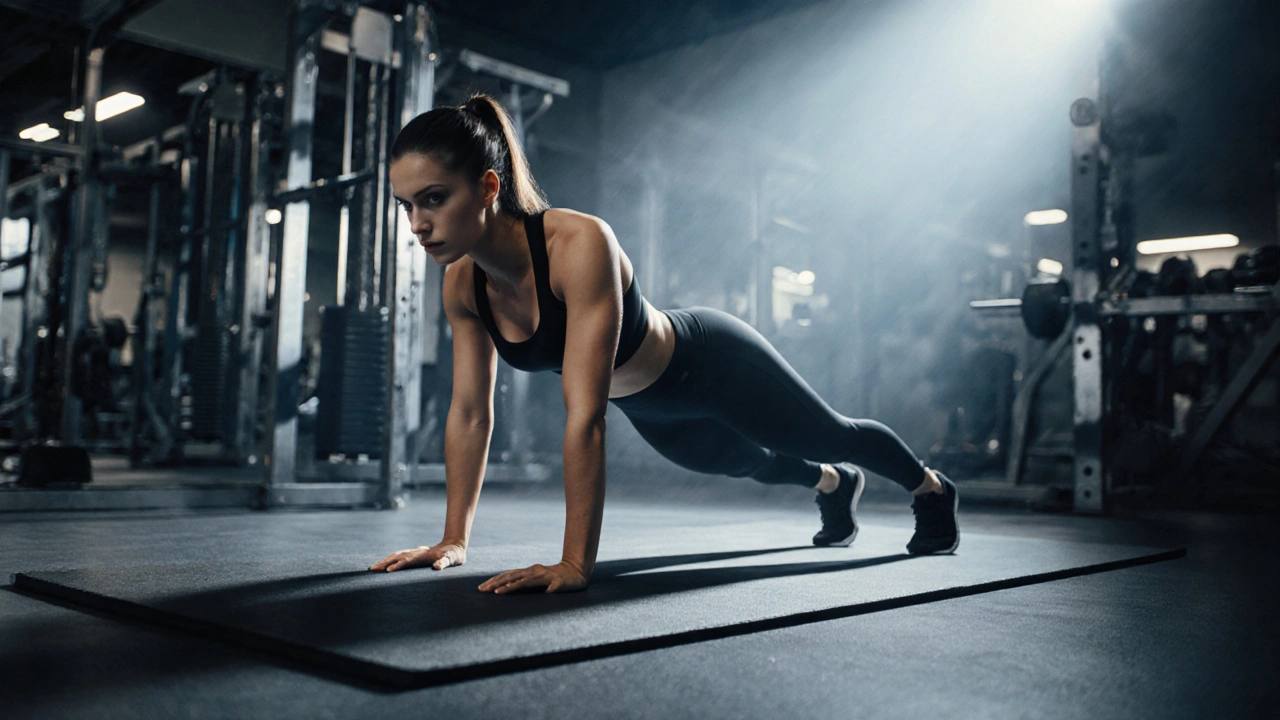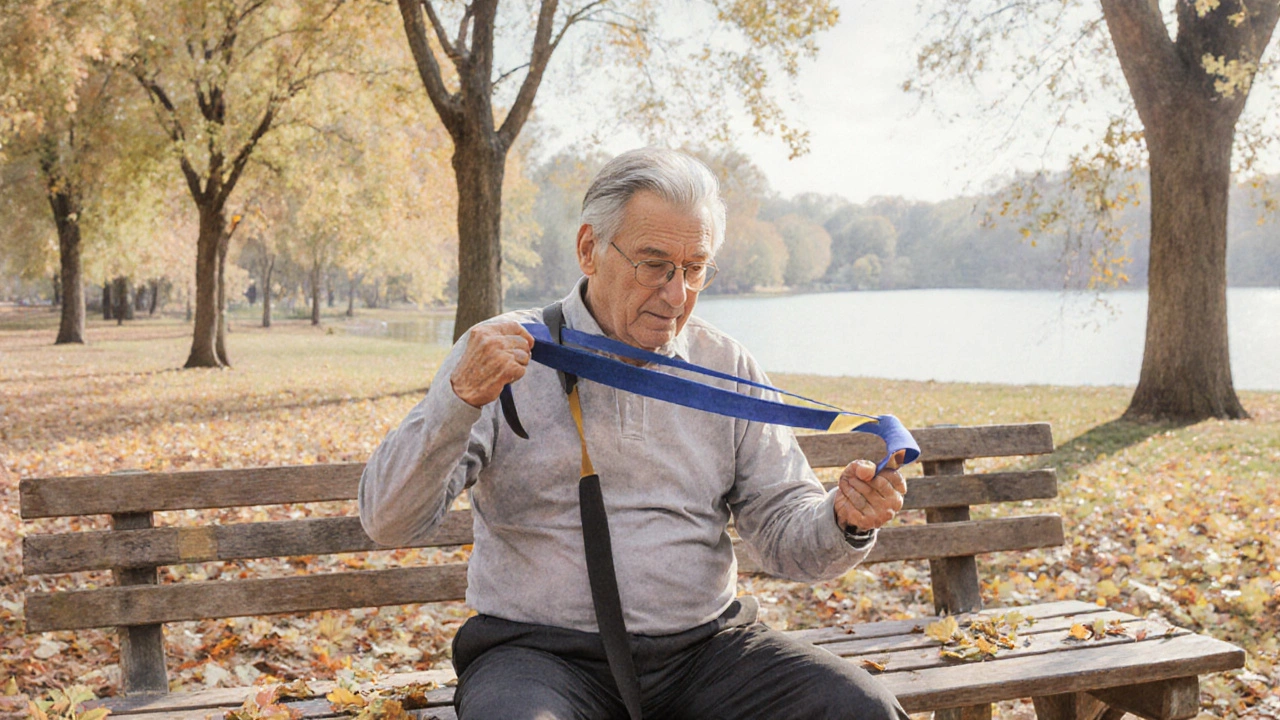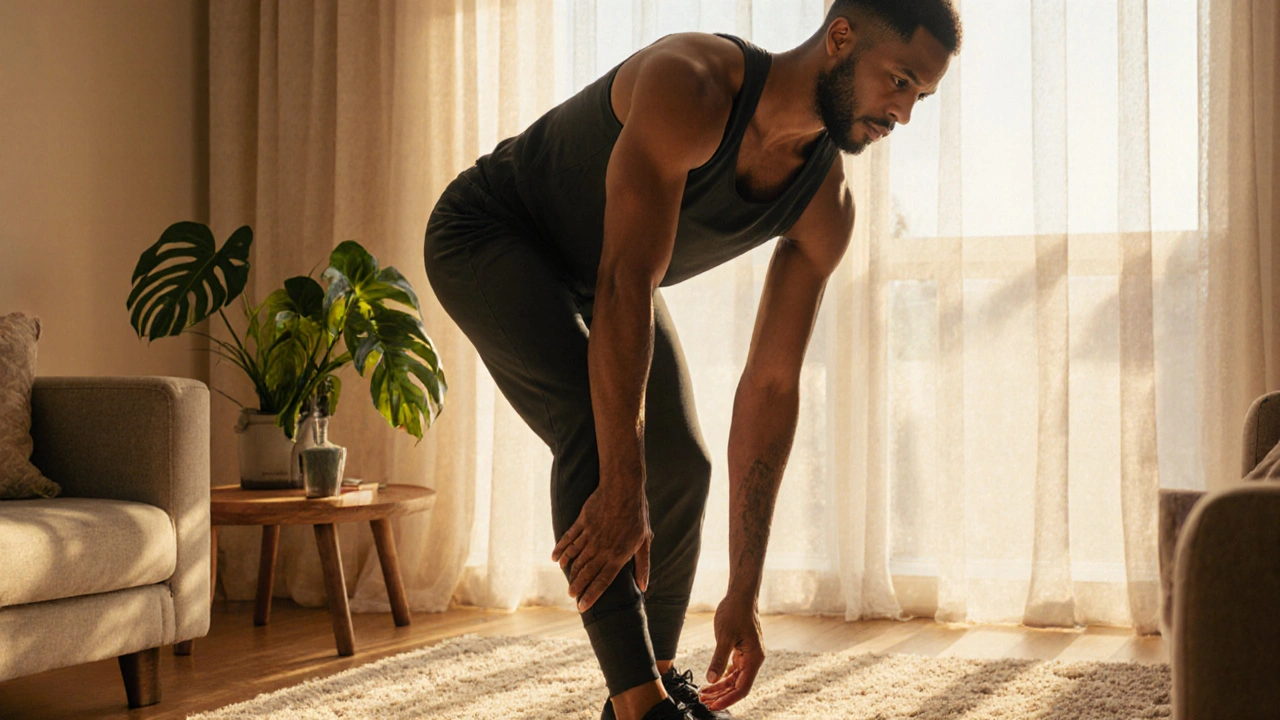Got those stubborn muscle aches after a long hike, a tough workout, or even a day at the desk? You don’t need a pricey massage or a week off. The right muscle ache relief exercises can melt tension, boost circulation, and get you moving again. Below you’ll find a practical mix of stretches and strength moves that target the most common sore spots - all explained in plain language and easy to slot into a daily routine.
Quick Take
- Hamstring Stretch - loosens back of thigh, 30‑second hold.
- Quadriceps Stretch - eases front‑thigh tightness, 30‑second hold.
- Calf Stretch - releases lower‑leg tension, 30‑second hold.
- Hip Flexor Stretch - combats seated‑day stiffness, 30‑second hold.
- Cat‑Cow Stretch - improves spine mobility, 10‑15 reps.
- Glute Bridge - strengthens posterior chain, 12‑15 reps.
- Wall Sit - builds endurance in quads, 45‑second hold.
- Foam Rolling - self‑myofascial release, 1‑2 minutes per muscle.
- Resistance Band Squat - adds load to squat, 12‑15 reps.
- Child’s Pose - calms nervous system, 30‑second hold.
1. Hamstring Stretch
Hamstring Stretch is a simple glide that lengthens the muscles along the back of your thigh. Sit on the floor, extend one leg, and gently lean forward, keeping the spine neutral. Hold for 30 seconds, then switch sides. Aim for a mild pull, not pain. Common mistake: rounding the back - keep your chest up to protect the lower back.
2. Quadriceps Stretch
Quadriceps Stretch is a standing stretch that targets the front thigh muscles. Grab your ankle behind you, pull heel toward the glutes while keeping knees together. Hold 30 seconds per leg. If balance is an issue, use a wall for support. Avoid pulling too hard, which can strain the knee joint.
3. Calf Stretch
Calf Stretch is a heel‑down posture that releases tension in the gastrocnemius and soleus muscles. Stand facing a wall, place hands on it, step one foot back, press the back heel into the ground. Keep the back leg straight for a deeper gastrocnemius stretch; bend slightly to target the soleus. Hold for 30 seconds, repeat on the other side.
4. Hip Flexor Stretch
Hip Flexor Stretch is a kneeling move that opens the muscles crossing the front of the hip. Kneel on one knee, other foot forward, and gently push hips forward while keeping the torso upright. Feel the stretch in the front of the rear thigh. Hold 30 seconds, then swap legs. Don’t arch the low back; engage the core to protect the spine.
5. Cat‑Cow Stretch
Cat‑Cow Stretch is a fluid spinal mobilization that alternates flexion and extension. Start on all fours, inhale to drop belly (Cow), lift head and tailbone. Exhale to round spine (Cat), tucking chin. Perform 10‑15 slow cycles. This move wakes up the entire back chain and improves circulation after prolonged sitting.

6. Glute Bridge
Glute Bridge is a floor‑based strengthening exercise for the glutes and hamstrings. Lie on your back, knees bent, feet hip‑width apart. Press through heels, lift hips until shoulders‑to‑knees form a straight line. Squeeze glutes at the top, hold 2 seconds, lower slowly. Aim for 12‑15 reps. Keep core engaged to avoid over‑arching the lower back.
7. Wall Sit
Wall Sit is an isometric squat that builds endurance in the quadriceps. Slide down a wall until thighs are parallel to the floor, knees above ankles. Hold for 45 seconds, rest 15 seconds, repeat 2‑3 times. If the hold feels too easy, lift one leg for an advanced variation.
8. Foam Rolling
Foam Rolling is a self‑myofascial release technique that reduces muscle adhesions. Position the foam roller under a sore muscle (e.g., calves or IT band), use body weight to roll slowly back and forth for 1‑2 minutes. Pause on tender spots for 20‑30 seconds. Avoid rolling directly over joints or bones.
9. Resistance Band Squat
Resistance Band Squat is a squat variation that adds external tension via an elastic band. Place a loop band just above the knees, stand shoulder‑width apart, and perform a regular squat while pushing knees outward against the band. This activates glutes and hip abductors, enhancing stability. Complete 12‑15 reps.
10. Child’s Pose
Child’s Pose is a restorative yoga position that gently stretches the back, hips, and shoulders. Kneel, sit back on heels, extend arms forward, and lower forehead to the floor. Hold for 30 seconds, breathing deeply. This pose calms the nervous system and promotes recovery after intense activity.
Putting It All Together: A Simple Daily Routine
Start with the mobility moves (Cat‑Cow, Child’s Pose) to wake the spine, then flow through the static stretches (Hamstring, Quadriceps, Calf, Hip Flexor). Follow with the strengthening set (Glute Bridge, Wall Sit, Resistance Band Squat) and finish with Foam Rolling to flush out any lingering tightness. Spend about 15‑20 minutes, and you’ll notice reduced soreness within a few days.
| Exercise | Type | Target Muscle(s) | Reps / Duration |
|---|---|---|---|
| Hamstring Stretch | Stretch | Hamstrings | 30sec each leg |
| Quadriceps Stretch | Stretch | Quadriceps | 30sec each leg |
| Calf Stretch | Stretch | Calves (gastrocnemius/soleus) | 30sec each leg |
| Hip Flexor Stretch | Stretch | Hip flexors | 30sec each side |
| Cat‑Cow | Stretch | Spine, core | 10‑15 reps |
| Glute Bridge | Strength | Glutes, hamstrings | 12‑15 reps |
| Wall Sit | Strength | Quadriceps | 45sec hold |
| Foam Rolling | Self‑Massage | Various (IT band, calves) | 1‑2min per zone |
| Resistance Band Squat | Strength | Glutes, quads, hips | 12‑15 reps |
| Child’s Pose | Stretch | Back, hips, shoulders | 30sec |

Frequently Asked Questions
How often should I do these exercises?
For general soreness, a short session once or twice a day works well. If you’re training hard, incorporate the routine after each workout and on rest days for optimal recovery.
Can I replace the stretches with yoga poses?
Absolutely. Many yoga poses, like Forward Fold or Low Lunge, target the same muscle groups. The key is to hold each position long enough to feel a gentle lengthening without bouncing.
What if I feel pain during a stretch?
Pain signals you’re over‑stretching or pressing on a joint. Back off a few degrees, keep breathing, and focus on the stretch, not the discomfort. If sharp pain persists, stop and consult a health professional.
Do I need equipment for these exercises?
Most moves need just a mat or a wall. A foam roller and a resistance band add extra value but aren’t mandatory. You can improvise with a towel for stretching or a sturdy towel‑wrapped book for extra pressure.
Will these exercises help chronic muscle tightness?
Consistent use can improve flexibility and blood flow, which often eases chronic tightness. Pair the routine with proper hydration, sleep, and balanced activity for the best long‑term results.


Veronica Rodriguez
September 28, 2025 AT 05:10Great rundown! 🙌 If you’re short on time, try pairing the calf stretch with a quick foam‑rolling pass on the shins – it boosts circulation in under a minute. Also, keep your spine neutral during the hamstring stretch; a slight hip hinge prevents lower‑back strain. 👟
Holly Hayes
October 1, 2025 AT 14:10Well, I must say the article is rather pedestrian, almost as if it were drafted by a gym‑novice who can’t distinguish between a proper lunge and a sloppy squat. The “quick take” feels more like a hastily scribbled list, definitely not the epitome of fitness literacy. You could certainly do better, maybe sprinkle in some real biomechanic insight for the discerning reader. lol
Matthew Shapiro
October 4, 2025 AT 23:10Actually, the list covers the fundamental movements quite well, and the emphasis on maintaining proper alignment is essential for injury prevention. Adding a cue to engage the core during the glute bridge would further enhance stability. Overall, it serves as a solid foundation for anyone looking to alleviate muscle soreness.
Maddie Wagner
October 8, 2025 AT 08:10Imagine stepping out of a long hike, muscles begging for mercy, and you have this arsenal at your fingertips – it’s like a symphonic rescue for every tight fibre! The routine isn’t just a series of motions; it’s a narrative where each stretch whispers relief, each strength move shouts resilience. Let’s honor our bodies by moving through these exercises with intention, feeling the tension melt away like snow under a sunrise.
Boston Farm to School
October 11, 2025 AT 17:10Loving the vibe it feels like a cultural bridge between yoga and strength training 🌍 the blend honors traditions while staying practical 🧘♀️💪
Emily Collier
October 15, 2025 AT 02:10Indeed, the convergence of mindfulness and muscular work mirrors the harmony between mind and body we often seek. When we treat each stretch as a moment of contemplation, we cultivate not only physical ease but also inner peace. Keep nurturing that balanced approach, and the aches will gradually dissolve into gratitude.
Catherine Zeigler
October 18, 2025 AT 11:10Starting a daily routine can feel daunting, but breaking it into manageable chunks makes the habit stick. Begin each session with the cat‑cow movement; this gentle spinal articulation awakens the nervous system and prepares the fascia for deeper work. Follow with the hamstring and quadriceps stretches, holding each for thirty seconds while focusing on steady breathing to enhance tissue extensibility. The calf stretch, performed with the heel pressed firmly into the floor, improves ankle dorsiflexion and reduces shin splints after running. Transition into the hip‑flexor stretch, keeping the torso upright to target the iliopsoas without over‑arching the lumbar region. After mobility work, shift to strength with the glute bridge, emphasizing a squeeze at the top to activate the posterior chain effectively. The wall sit, held for forty‑five seconds, builds quadriceps endurance crucial for climbing stairs and hiking uphill. Incorporate the resistance band squat to add lateral tension, which reinforces hip abductors and stabilizes knee tracking. Finish the strengthening circuit with a brief pause, allowing heart rate to settle before moving to recovery. Foam rolling should be applied to each major muscle group for one to two minutes, lingering on tender spots to promote blood flow. Conclude the session with child’s pose, letting the shoulders relax and the breath deepen, signalling the nervous system to shift toward parasympathetic dominance. Remember to stay hydrated throughout, as water facilitates metabolic waste removal from worked tissues. Aim to perform this routine at least once daily, or post‑workout, to maximize recovery benefits. Consistency is the key: even a fifteen‑minute session reapplied regularly will outperform sporadic hour‑long efforts. Celebrate each small gain, and you’ll notice less stiffness, improved mobility, and a brighter mood after each workout.
henry leathem
October 21, 2025 AT 20:10While the author attempts a holistic schema, the protocol suffers from a lack of periodization and fails to address the neuromuscular recruitment hierarchy essential for optimal hypertrophic adaptation; the absence of progressive overload renders the prescription functionally inert.
jeff lamore
October 25, 2025 AT 05:10Thank you for presenting a comprehensive overview of muscle‑ache mitigation strategies. The delineation between flexibility and strength components is commendable, and the inclusion of foam rolling offers a pragmatic self‑myofascial option. I appreciate the clear formatting and concise instructions.
Kris cree9
October 28, 2025 AT 13:10Honestly this read felt like a snooze fest, sooo boring i cant even... the whole thing coulda been a single paragraph and I'd still be more awake!
Paula Hines
October 31, 2025 AT 22:10When one contemplates the very essence of corporeal discomfort it becomes evident that the suggested regimen merely skims the surface of a deeper biomechanical discourse that has been long neglected by mainstream fitness narratives the interplay between fascial tension and neural inhibition demands a more nuanced approach that transcends simple static holds and repetitive motions true recovery necessitates an integrative protocol that marries diaphragmatic breathing with proprioceptive awareness thereby engendering a state of homeostatic equilibrium that ultimately dissolves the perception of pain
John Babko
November 4, 2025 AT 07:10Indeed, the points raised are compelling, however, one might also consider the timing of each exercise, the sequencing relative to circadian rhythms, and the potential synergistic effects when combined with nutritional strategies, such as adequate protein intake, omega‑3 supplementation, and proper hydration, all of which could amplify the benefits outlined above.
Hanna Sundqvist
November 7, 2025 AT 16:10huh the child pose is kinda weird.
Jim Butler
November 11, 2025 AT 01:10While the sensation may feel unfamiliar initially, Child’s Pose is designed to gently decompress the lumbar vertebrae and promote relaxation; with consistent practice the perceived oddity typically transforms into a soothing ritual. 😊
Ian McKay
November 14, 2025 AT 10:10The article correctly references the primary muscle groups, yet it erroneously capitalizes “Quadriceps” in the table; proper noun usage is unnecessary in this context.
Deborah Messick
November 17, 2025 AT 19:10Although the capitalization could be viewed as a stylistic choice, one might argue that uniform capitalization enhances readability and maintains a consistent visual hierarchy throughout the document.